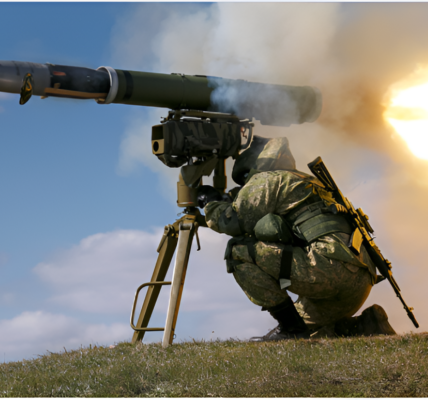
History is filled with examples of once-powerful competitors who failed to adapt quickly enough to evolving challenges. From nature’s most resilient creatures to powerful nation-states, survival and victory hinge on the ability to adapt. This lesson is particularly evident on the battlefields of Ukraine, where rapid technological evolution and adaptive tactics are reshaping the nature of conflict. If the United States does not learn from these lessons, it risks falling behind in a world where military prowess is increasingly defined by adaptability rather than sheer strength.
Consider the Excalibur precision artillery shells initially supplied by the U.S. to Ukraine. These munitions were highly effective at first, but within just a few months, Russian forces adapted their tactics to neutralize the advantage. In modern warfare, technology evolves at breakneck speeds — software updates come daily, hardware is iterated weekly, and operational strategies shift hourly. The United States must rethink its defense acquisition model, or face obsolescence in the face of faster-moving adversaries.
The U.S. military’s traditional defense acquisition model is slow, bureaucratic, and rooted in a top-down process designed for long-term projects. In a conflict against a modern adversary, this model risks being outdated by the time the first shots are fired. U.S. technology can become obsolete as soon as the dust settles, especially in a protracted war against an adaptive enemy. To stay competitive, the U.S. military must explore a new way forward: shifting from a product-based defense model to a service-based one that can evolve on the fly.
As a venture investor working in the national security space, I acknowledge the challenge of this shift. While it may seem counterintuitive for the defense industry to move toward more complex, less efficient manufacturing processes and global distribution, these changes are necessary to enable real-time adaptation. My goal isn’t to reshape the Department of Defense to accommodate industry demands — it’s about transforming the industry itself to meet the demands of modern warfare. Our current pace of adaptation simply isn’t fast enough. We need to fix that.
Modern adversaries are increasingly leveraging commercially available technologies — like drones, 3-D printing, and satellite imaging — to adapt quickly. Ukraine’s drone war is a prime example: Ukrainian forces initially used drones to ram Russian drones, but Russia soon adapted by equipping drones with munitions and enhancing AI targeting. Ukrainian forces responded with AI-based systems to counter Russian tactics, while Russia turned to camouflage and dazzle paint schemes to evade detection. This dynamic back-and-forth underscores the speed of adaptation that defines modern warfare.
What happens when an adversary introduces a new technology that shifts the balance of power? The U.S. military must be able to respond quickly, not in months or years but in weeks. Consider the U.S. military’s experience with mine-resistant ambush-protected vehicles during the Iraq and Afghanistan conflicts. Although this initiative was critical to saving lives, it took over three years to get the first units into service. Today, this timeline is unacceptable, especially as enemies innovate faster than the U.S. can adapt.
One of the U.S. military’s biggest challenges is its traditional approach to acquiring new technologies, which is often fixated on rigid product specifications. The lengthy process for establishing requirements, acquiring solutions, and fielding products means that by the time technology is deployed, it may be obsolete. The Joint Capabilities Integration and Development System (JCIDS) is a prime example of this, taking an average of two years to define and develop a new capability. While faster acquisition methods exist, they still fall short of the rapid response required on today’s battlefield.
The solution? Reimagine the requirements process. Instead of specifying rigid product solutions, the U.S. military should focus on desired outcomes — more general, adaptable objectives. For example, instead of specifying the design of a drone to clear adversarial drones from friendly airspace, the requirement should focus on the outcome: clearing friendly airspace. By focusing on outcomes, contractors can use a range of solutions, creating flexible, service-based contracts that allow for continuous improvement rather than one-time, static products. This “Defense as a Service” model enables more rapid iterations and software-like updates, allowing the military to stay ahead of evolving threats.
This approach isn’t entirely new. During the Global War on Terror, U.S. military drones like the Predator were operated by private contractors, providing valuable lessons in how a service-based model can deliver battlefield advantage. Similarly, the U.S. Coast Guard has already embraced the concept by awarding Shield AI an indefinite delivery, indefinite quantity contract to provide surveillance as a service using its V-BAT platform. These are steps in the right direction, but much more needs to be done to fully shift toward an outcome-based model.
Real-time adaptation requires more than just flexible requirements and service-based contracts. The U.S. must embed engineers on the frontlines, not just combat engineers focused on infrastructure, but the very architects of the technology being used in the field. This on-the-ground presence allows engineers to observe how equipment performs under actual combat conditions and adjust designs on the fly.
Palantir, for example, uses forward-deployed engineers to help users optimize their intelligence platform. Similarly, companies developing counter-drone technologies embed their engineers in forward operating bases to witness firsthand how adversaries adapt to their systems. This direct feedback loop ensures that technology evolves in real time, offering a significant advantage in conflict.
Some might argue that placing engineers in combat zones increases risk. But in a future conflict, every part of the nation must contribute to the war effort. Engineers should be integrated into tactical teams, working directly with soldiers to ensure that technology adapts to the fast-moving realities of modern warfare.
For true adaptability, manufacturing must be moved closer to the battlefield. Traditional manufacturing is slow, and the distance between factories and combat zones can lead to delays in delivery and adaptation. By creating forward-deployed manufacturing hubs — perhaps aboard decommissioned ships or military planes — the U.S. military could dramatically reduce lead times for prototyping, testing, and producing new technologies.
Advanced techniques like 3-D printing and modular production can enable these hubs to manufacture customized solutions on demand, from drones to sensors, delivering them directly to the frontlines within days. Firestorm, a company I’m involved with, provides a great example. Its modular small unmanned aerial systems can be rapidly adapted like a Lego set to meet changing mission requirements. These systems are produced in mobile factories embedded in shipping containers, offering a flexible, scalable solution that could be deployed anywhere in the world.
Moving manufacturing closer to the battlefield ensures that the U.S. military is not just reactive but proactive, able to respond to emerging threats with speed and precision.
The rapid pace of technological change on today’s battlefield demands a fundamental shift in how the U.S. military develops, acquires, and adapts its capabilities. Moving away from a product-focused, static defense model to a service-oriented, outcomes-based approach — combined with embedded engineers and proximal manufacturing — can ensure that the U.S. military stays ahead of its adversaries.
In the future, the military will need to be a dynamic, ever-evolving force. It can no longer rely on static solutions that gather dust in a toolbox. Instead, it must be adaptable, like a Swiss Army knife capable of evolving and changing with each new threat. The force that wins will be the one that can adapt fastest, and the U.S. must prepare to be that force.


